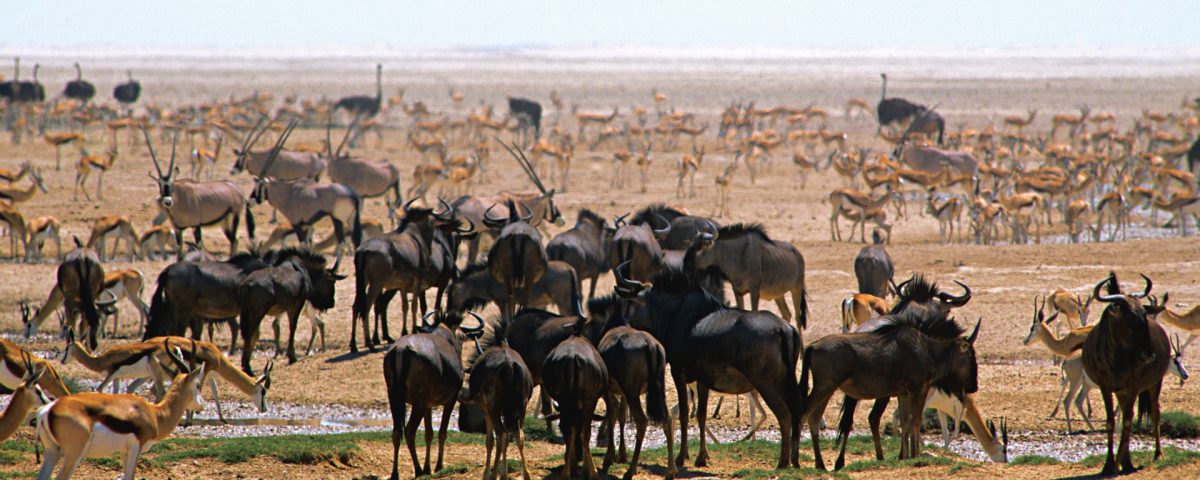Text Tim Osborne | Photographs Paul van Schalkwyk, Tim Osborne
The best plan of action when visiting the Etosha National Park, rather than rushing around in search of lions, is to spend time at each waterhole watching the different animals come to drink
A fter a while you begin to notice that not all animals were created equal. While some walk straight to the water, others first stop and wait. If you spend an hour or two at a waterhole favoured by many different species, you’ll see that there is a definite pecking order. This is most pronounced at small waterholes where space to drink is limited.
The hierarchy might surprise you. Whereas having the finest set of horns will impress members of your own kind, this will not advance your status with other species one bit. Of the big game, the lowest-ranking member is the kudu. A majestic kudu bull with 60-inch horns drinking at a waterhole when another plains-game animal arrives, rapidly moves aside or backs off to wait until the newcomer has drunk its fill. Next up on the list is the gemsbok with its sharp, pointed sabre-like horns. This antelope can make a kudu back off, but moves away rapidly if a red hartebeest arrives. Next is an animal without any horns – the zebra. Zebra frequently arrive with other species, but are given the best drinking position, although amongst themselves they often kick and push for a spot.
Size doesn’t matter to the next animal on the list. The lowly warthog simply barges in, scattering any animals that are there. Often, rather than drinking at the edge, they plunge right into the water, stirring up the mud. Eland and blue wildebeest seem to be equals and drink together, but are higher ranking than the animals listed thus far. Both usually occur in herds, so are probably more tolerant of each other. Still the kudu waits.
There are two birds that make the list. The ostrich – which is not water dependent – still enjoys water when it is available. Ostrich even rank above eland and wildebeest. When these large flightless birds occupy a waterhole, the rest of the animals stand back until they have had their fill. The other bird is the kori bustard. Koris are among only a few birds that do not bill-dip to drink, but rather suck the water directly into their throats. They often kneel down on their shins to drink. At the Okaukuejo waterhole I once watched a kori try to drink at noon during what looked like rush hour. It wouldn’t tolerate any mammals walking behind it as it drank, but kept turning around, spreading its wings and pecking at springbok, gemsbok and zebra. It made contact with several springbok. The kori even chased off an approaching giraffe.
Giraffe are probably above eland in the pecking order, but I have rarely seen these two species drinking at the same time. The giraffe makes itself vulnerable by spreading its front legs far apart to get low enough to drink, so it spends lots of time waiting and watching for predators.

At the top of the list are elephant and black rhino. Purely by virtue of their size, they easily dominate the waterhole. You would think that such huge animals would be mellower, but they, at least the younger ones, are often waterhole bullies, chasing off the other animals. It’s hard to say whether elephant or rhino are at the very top of the hierarchy. At the Okaukuejo waterhole one night in 2000 I witnessed a three-ring circus taking place. There were nine lionesses trying to kill a baby black rhino in the far reaches of the floodlit area. They kept leaping onto the back of the calf, but its mother attacked them, using her horn. The calf also fended off the lions with its little horn.
Also at the waterhole was a large male elephant trying to push a black rhino out of the way. The rhino countered with bellows and charges of its own. This aggressive action went back and forth for about five minutes until the elephant broke away and came to the near side to drink at the freshwater inlet. It headed back towards the rhino, but stopped to let a large male giraffe pass. Once the giraffe was out of the way, the elephant charged the rhino again. The rhino triumphed once more, the elephant retreated to the edge of the darkness 200 metres away, and the rhino continued drinking.
Meanwhile the lions were still trying their luck attacking the young rhino. One of them broke away and rose up underneath the drinking giraffe, as if trying to size up where to attack. The giraffe stood up, backed away and quickly departed. Meanwhile the male elephant returned and charged the rhino again. It was swiftly repulsed and, as before, retreated off into the darkness. Several staff members were watching with me. One of them turned and said, “We have a new King of the Waterhole!”
This article was first published in the Flamingo June 2011 issue.




